Newfoundland (dog)
The Newfoundland dog is a large working dog. They can be either black, brown, or white-and-black. However, in the Dominion of Newfoundland, before it became part of the confederation of Canada, only black and Landseer coloured dogs were considered to be proper members of the breed.[2] They were originally bred and used as working dogs for fishermen in Newfoundland.[3][4] Newfoundland dogs are known for their giant size, intelligence, tremendous strength, calm dispositions, and loyalty. They excel at water rescue/lifesaving because of their muscular build, thick double coat, webbed paws, and swimming abilities.
| Newfoundland | |||||||||||||||||||||||||||||||||
|---|---|---|---|---|---|---|---|---|---|---|---|---|---|---|---|---|---|---|---|---|---|---|---|---|---|---|---|---|---|---|---|---|---|
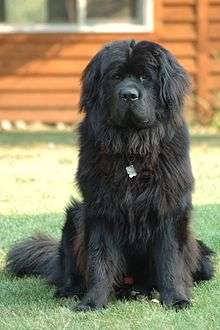 Newfoundland dog | |||||||||||||||||||||||||||||||||
| Origin | Island of Newfoundland, modern-day Canada | ||||||||||||||||||||||||||||||||
| |||||||||||||||||||||||||||||||||
| |||||||||||||||||||||||||||||||||
| Notes | Provincial mammal of Newfoundland | ||||||||||||||||||||||||||||||||
| Dog (domestic dog) | |||||||||||||||||||||||||||||||||
Description
Appearance
The Newfoundlands ('Newfs' or 'Newfies') have webbed paws and a water-resistant coat.[5] Males normally weigh 65–80 kg (143–176 lb), and females 55–65 kg (121–143 lb), placing them in the "Giant" weight range; but some Newfoundland dogs have been known to weigh over 90 kg (200 lb) – and the largest on record weighed 120 kg (260 lb) and measured over 1.8 m (6 ft) from nose to tail, ranking it among the largest of dog breeds. They may grow up to 56–76 cm (22–30 in) tall at the shoulder.[6]
The American Kennel Club (AKC) standard colours of the Newfoundland dogs are black, brown, grey, and white-and-black (sometimes referred to as Landseer). Other colours are possible but are not considered rare or more valuable. The Kennel Club (KC) permits only black, brown, and white/black; the Canadian Kennel Club (CKC) permits only black and white/black. The "Landseer" pattern is named after the artist, Sir Edwin Henry Landseer, who featured them in many of his paintings. Fédération Cynologique Internationale (FCI) consider the ECT Landseer ("European Continental Type") to be a separate breed. It is a taller, more narrow white dog with black markings not bred with a Newfoundland.[6]
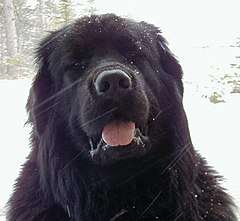

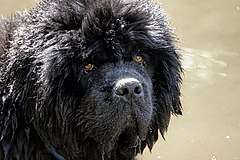
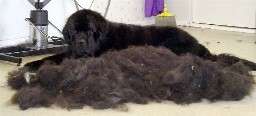

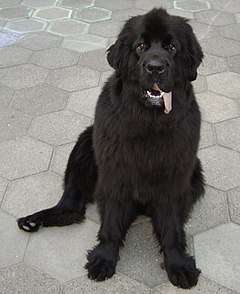
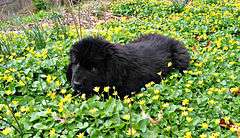
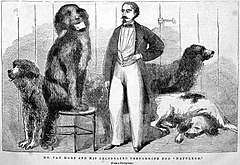

_-_Lion-_A_Newfoundland_Dog_-_Google_Art_Project.jpg)
The Newfoundland's extremely large bones give it mass, while its large musculature gives it the power it needs to take on rough ocean waves and powerful tides. These dogs have huge lung capacity for swimming extremely long distances and a thick, oily, and waterproof double coat which protects them from the chill of icy waters.[7] The double coat makes the dog hard to groom, and also causes a lot of shedding to occur. The droopy lips and jowls make the dog drool, especially in high heat.
In the water, the dog's massive webbed paws give it maximum propulsion. The swimming stroke is not an ordinary dog paddle: Unlike other dogs, the Newfoundland moves its limbs in a down-and-out motion giving more power to every stroke.
Temperament
The Newfoundland dog is known for its calm and docile nature and its strength. They are highly loyal and make ideal working dogs. It is for this reason that this breed is known as "the gentle giant". International kennel clubs generally describe the breed as having a sweet temper.[5][8][9] It typically has a deep bark and is easy to train if started young. They are wonderfully good with children, but small children can get accidentally leaned on and knocked down. Newfoundlands are ideal companions in the world of therapy and are often referred to as the nanny dog. The breed was memorialized in "Nana", the beloved guardian dog in J. M. Barrie's Peter Pan.[upper-alpha 1] The Newfoundland, in general, is good with other animals, but its size can cause problems if it is not trained.
A Newfoundland's good, sweet nature is so important, it is listed in the Breed Standards of many countries; dogs exhibiting poor temperament or aggression are disqualified from showing and should never be used to breed. The breed standard in the United States reads that "Sweetness of temperament is the hallmark of the Newfoundland; this is the most important single characteristic of the breed."[10]
Health
There are several health problems associated with Newfoundlands. Newfoundlands are prone to hip dysplasia (a malformed ball and socket in the hip joint). They also get elbow dysplasia, and cystinuria (a hereditary defect that forms calculi stones in the bladder). Another genetic problem is subvalvular aortic stenosis (SAS). This is a common heart defect in Newfoundlands involving defective heart valves. SAS can cause sudden death at an early age. It is similar to having a heart attack. It is common that "Newfs" live to be 8 to 10 years of age; 10 years is a commonly cited life expectancy.[11] But, Newfoundlands can live up to 15 years old.[12]
History
Origin
The Newfoundland breed originated on Newfoundland, and is descended from a breed indigenous to the island known as the lesser Newfoundland, or St. John's dog. DNA analysis confirms that Newfoundlands are closely related to other Canadian retrievers, including the Labrador, Nova Scotia Duck Tolling Retriever, Golden Retrievers, and Flat Coated Retrievers.[13]
By the time colonization was permitted in Newfoundland in 1610, the distinct physical characteristics and mental attributes had been established in the Newfoundland breed. In the early 1880s, fishermen and explorers from Ireland and England traveled to the Grand Banks of Newfoundland, where they described two main types of working dog. One was heavily built, large with a longish coat, and the other medium-sized in build – an active, smooth-coated water dog. The heavier breed was known as the Greater Newfoundland, or Newfoundland. The smaller breed was known as the Lesser Newfoundland, or St. John's dog. The St. John's dog became the founding breed of the modern retrievers. Both breeds were used as working dogs to pull fishnets, with the Greater Newfoundland also being used to haul carts and other equipment.
The Molosser-like appearance of the Newfoundland is a result of an introduction of Mastiff blood[13], possibly from breeding with Portuguese Mastiffs brought to the island by Portuguese fishermen beginning in the 16th century. It has also been proposed that the original Newfoundland that lived on the island was smaller[14][15]; in theory, the smaller landrace was bred with mastiffs when sold to the English, and the English version was popularized to become what we think of as a Newfoundland today.[16]
Reputation
The breed's working role was varied. Many tales have been told of the courage displayed by Newfoundlands in adventuring and lifesaving exploits. Over the last two centuries, this has inspired a number of artists, who have portrayed the dogs in paint, stone, bronze, and porcelain. One famous Newfoundland was a dog named Seaman, who accompanied American explorers Lewis and Clark on their expedition.
The breed prospered in the United Kingdom, until 1914 and again in 1939, when its numbers were almost fatally depleted by wartime restrictions. Since the 1950s there has been a steady increase in numbers and popularity, despite the fact that the Newfoundland's great size and fondness for mud and water makes it unsuitable as a pet for many households.[17]
William Withering, famous for his book on the use of Dropsy published in 1785, lived at Edgbaston Hall, Birmingham between 1786 and 1799. While there, he bred Newfoundland Dogs. There is very little else on his experiments with these dogs. His daughter Charlotte married a Beriah Botfield and they had a painting in Norton Hall by Samuel Cox of Daventry painted about 1830-1840 called "Portrait of Lion, a Newfoundland Dog, and Juba, a Pug Dog of Mrs. Botfield's. This hung in the north front of Norton Hall. This painting would have been made around the same time that Landseer painted his portrait of Lion, the Newfoundland Dog. (See 'Catalogue of Pictures in the possession of Beriah Botfield esq.at Norton Hall' published in London in 1848.
Water rescue
During the Discovery Channel's second day of coverage of the AKC Eukanuba National Championship on December 3, 2006, anchor Bob Goen reported that Newfoundlands exhibit a very strong propensity to rescue people from water. Goen stated that one Newfoundland alone once aided the rescue of 63 shipwrecked sailors. Today, kennel clubs across the United States host Newfoundland Rescue Demonstrations, as well as offering classes in the field. Many harbor boat tours in St. John's have a dog on board for local charm as well as for passenger safety.
- An unnamed Newfoundland is credited for saving Napoleon Bonaparte in 1815. During his famous escape from exile on the island of Elba, rough seas knocked Napoleon overboard. A fisherman's dog jumped into the sea, and kept Napoleon afloat until he could reach safety.[18]
- In 1828, Ann Harvey of Isle aux Morts, her father, her brother, and a Newfoundland named Hairyman saved over 160 Irish immigrants from the wreck of the brig Despatch.
- In 1881 in Melbourne, Australia, a Newfoundland named Nelson helped rescue Thomas Brown, a cab driver who was swept away by flood waters in Swanston Street on the night of 15 November. While little is known about what became of Nelson, a copper dog collar engraved with his name has survived and 130 years after the rescue it was acquired by the National Museum of Australia and is now part of the National Historical Collection.[19]
- In the early 20th century, a dog that is thought to have been a Newfoundland saved 92 people who were on the SS Ethie which was wrecked off of the Northern Peninsula of Newfoundland during a blizzard. The dog retrieved a rope thrown out into the turbulent waters by those on deck, and brought the rope to shore to people waiting on the beach. A breeches buoy was attached to the rope, and all those aboard the ship were able to get across to the shore including an infant in a mailbag. Wreckage of the ship can still be seen in Gros Morne National Park. E. J. Pratt's poem "Carlo", in the November 1920 issue of the Canadian Forum, commemorates this dog.
- In 1995, a 10-month-old Newfoundland named Boo saved a hearing-impaired man from drowning in the Yuba River in Northern California. The man fell into the river while dredging for gold. Boo noticed the struggling man as he and his owner were walking along the river. The Newfoundland instinctively dove into the river, took the drowning man by the arm, and brought him to safety. According to Janice Anderson, the Newfoundland’s breeder, Boo had received no formal training in water rescue.[20]
Further evidence of Newfoundlands' ability to rescue or support life-saving activities was cited in a 2007 article by the BBC.[21]
Relationship to other breeds
The Newfoundland shares many physical traits with Mastiffs and Molosser type dogs, such as the St. Bernard and English Mastiff, including stout legs, massive heads with very broad snouts, a thick bull neck, and a very sturdy bone structure.[22] Many St. Bernard Dogs have Newfoundland Dog in their ancestry. Newfoundlands were brought and introduced to the St. Bernard breed in the 18th century when the population was threatened by an epidemic of distemper. They share many characteristics of many livestock guardian dog breeds such as the Great Pyrenees.
Because of their strength, Newfoundlands were part of the foundation stock of the Leonberger (which excelled at water rescue and was imported by the Canadian government for that purpose); and the now extinct Moscow Water Dog, a failed attempt at creating a lifesaving dog by the Russian state kennel—the unfortunate outcross with the Caucasian Ovcharka begat a dog more adept at biting than rescuing.
Famous Newfoundlands
Napoleon the Wonder Dog
A famous all-black Newfoundland performed as the star attraction in Van Hare's Magic Circus from 1862 and for many years thereafter in one of England's founding circus acts, traveling throughout Europe. The circus dog was known as the "Thousand Guinea Dog Napoleon" or "Napoleon the Wonder Dog." The circus owner, G. Van Hare, trained other Newfoundland dogs to perform a steeplechase routine with baboons dressed up as jockeys to ride them. Nonetheless, his "wizard dog" Napoleon was his favorite and held a special position in the Magic Circus. Napoleon would compete at jumping against human rivals, leaping over horses from a springboard, and dancing to music.[23][24]
Napoleon the Wonder Dog became a wildly popular act in London from his debut at the Pavilion Theatre on April 4, 1862, and onward until his untimely death many years later when he slipped and fell during a circus practice session. At the peak of his fame, his performance was described in London's Illustrated Sporting News and Theatrical and Musical Review as follows: "Synopsis of his entertainment:-- He spells his own name with letters' also that of the Prince of Wales; and when he is asked what he would say of her Most Gracious Majesty, he puts down letters to form "God save the Queen." He plays any gentleman a game of cards and performs the celebrated three-card trick upon which his master backs him at 100 to 1. Also "The Disappearance," a la Robin. He performs in a circus the same as a trick horse, en liberté, giving the Spanish trot to music, also leaping over bars, through balloons, with numerous other tricks of a most interesting character." [25]
When Napoleon the Wonder Dog died, as a result of a circus accident at the age of 11 years old, his passing was announced in a number of British newspapers, including the Sheffield Daily Telegraph, which mentioned the loss on May 5, 1868, as follows: "DEATH OF A CELEBRATED FOUR-FOOTED ARTISTE. -- Mr. Van Hare's renowned dog, Napoleon, designated 'The Wizard Dog,' died on 24th ult., aged twelve years. He was a noble specimen of the Newfoundland breed (weighing near 200 lbs.) for which he took the prize at the first Agricultural Hall Dog Show. Besides his magnificent appearance and symmetry, he was the most extraordinary sagacious and highly-trained animal ever known. He is now being preserved and beautifully mounted by the celebrated naturalist, Mr. Edwin Ward. -- Era."[26]
Other famous dogs
- Adam: Seaward's Blackbeard: 1984 Best in Show winner at the Westminster Dog Show
- Anton: A heavy weight and stubborn dog, often refusing to walk, but rather sits down to get ham. A national celebrity in Norway, featured in talk show Lindmo, after being the star in a dog training TV-show. [27]
- Bashaw (Matthew Cotes Wyatt): The Earl of Dudley's favourite dog, a sculpture by Matthew Cotes Wyatt at the Victoria and Albert museum in London
- Beckham: Matt Murray’s dog
- Bilbo: a lifeguard Newfoundland on Sennen beach in Cornwall—credited with saving three lives.[28]
- Boatswain: pet of English poet Lord Byron and the subject of his poem "Epitaph to a Dog". Byron attempted to nurse Boatswain back to health when the dog contracted rabies, but was unsuccessful. When Boatswain died, Byron constructed a monument for him at Newstead Abbey.
- Bouncer: Presented by the children of Newfoundland, with a dog-cart,[29] as a gift to the Duke & Duchess of Cornwall and York (later George V and Queen Mary), during their visit to the colony in 1901.[30][31]
- Brumus: Robert F. Kennedy's dog
- Bummer: A stray Newfoundland, or Newfoundland cross, that was known to roam the streets of San Francisco in the early 1860s, often accompanied by another dog named Lazarus.
- Carlo: Emily Dickinson's dog
- Charlie Erhart: Lyndon B. Johnson's dog
- Faithful: First dog of President Ulysses S. Grant[32]
- Frank: Unofficial mascot of the Orphan Brigade during the American Civil War[33]
- Gander: The WW2 mascot of the Royal Rifles of Canada, also known as "Sergeant Gander", which was killed in action at the Battle of Hong Kong when he carried a grenade away from wounded soldiers. For this, he was awarded the PDSA Dickin Medal retroactively in 2000.[34] A memorial statue can be viewed at the Gander Heritage Memorial Park (Gander, NL).[35]
- Hairy Man: The dog that helped Ann Harvey and her father and brother rescue 163 people from a shipwreck.
- Jeff: Wonderful gorilla-loving friend of Flagstaff, AZ; mascot of dream pop band the Sea Section [36]
- Josh: CH Darbydale's All Rise Pouch Cove: 2004 Best in Show winner at the Westminster Dog Show
- Leo: Matt Murray's younger dog
- Luath: Landseer Newfoundland pet of J. M. Barrie and the inspiration for "Nana," the Darling children's nurse in Peter Pan.
- Marlowe: Newfoundland/Golden Retriever Mix, known for being perfect and spoon-fed
- Napoleon the Wonder Dog: the famous circus dog from England in the 1860s, part of Van Hare's Magic Circus.
- Neptune: Sir John Franklin's dog who accompanied Franklin's lost expedition.
- Plato: pet of John James Audubon.
- Pluto: pet of the Croatian operatic soprano Ilma de Murska, which used to dine at table with her and was trained to eat a cooked fowl from a place setting without dripping gravy on the tablecloth.[37] Pluto lived in the 1860s.
- Rigel: mythical pet of first officer William Murdoch aboard the RMS Titanic. Murdoch went down with the ship but Rigel swam for three hours next to a lifeboat until it was rescued by the RMS Carpathia. Rigel is renowned as a hero alerting the Carpathia's captain of the weakened survivors before the ship hit them. Rigel was adopted by crewman Jonas Briggs.[38]
- Robber: dog of Richard Wagner, which accompanied him on his flight from his creditors from Riga on a fishing boat; an event that inspired the opera The Flying Dutchman.[39]
- Russ: last dog of Richard Wagner, buried at the feet of his master in the composer's tomb in the park of Villa Wahnfried in Bayreuth, under his own plaque: "Here rests and watches Wagner's Russ."
- Sable Chief: WW1 mascot of Royal Newfoundland Regiment.
- Seaman: once thought to have been named Scannon, this dog was a companion of explorer Meriwether Lewis on the Lewis and Clark Expedition of 1804 to 1806. His collar tag reads, The greatest traveller of my species. My name is SEAMAN, the dog of captain Meriwether Lewis, whom I accompanied to the Pacifick [sic] ocean through the interior of the continent of North America.[40]
- Smokey: the lion-styled mascot of the East Coast Bays Barracudas.
- SONAR: The naval mascot, was "recruited" into the Canadian Forces Maritime Command in 2010 as part of the Canadian navy’s centennial celebrations.[41]
- Swansea Jack: famous Welsh rescue dog identified as a Newfoundland, but which had an appearance more like a modern Flat-Coated Retriever
Famous fictional Newfoundlands
- Bonkers: pet of the Percy family in The World According to Garp, by John Irving
- Carl: pet of Teddy Armstrong of Anne Of Windy Poplars, by Lucy Maud Montgomery.
- Crusoe: main character of The Dog Crusoe and His Master (1860), by R. M. Ballantyne
- Curly: a minor character in Jack London's Call of the Wild
- Lion: pet of Henry Gowan in Charles Dickens' Little Dorrit
- Lou: companion to Officers Mahoney and Shtulman in the 1985 film Police Academy 2
- Mother Teresa: major canine character in the film Must Love Dogs
- Nana: The 'nurse' dog of Wendy, John and Michael in J. M. Barrie's Peter Pan
- Norma: Ippolit's dog in Dostoevsky's novel The Idiot, Part three, Chapter 5, 1868
- Pilot: pet of Edward Fairfax Rochester in Charlotte Brontë's classic novel Jane Eyre (1847), first described in chapter 12
- Pollux: pet of Lieutenant William Babbington in Patrick O'Brian's novel Desolation Island
- Rollo: Effi and Geert Von Instetten's dog in Effi Briest, by Theodor Fontane
- Tiger: companion of Arthur Gordon Pym in The Narrative of Arthur Gordon Pym of Nantucket, a novel by Edgar Allan Poe (1838)
Gallery
 Brown Newfoundland
Brown Newfoundland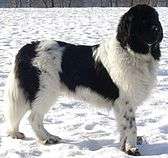 Landseer dog
Landseer dog- Black Newfoundland
 Newfoundland portrait
Newfoundland portrait
References
Notes
- Used as a nanny by the Darling family, Nana does not speak or do anything beyond the physical capabilities of a large dog, but acts with apparent understanding of her responsibilities. The character is played in stage productions by an actor in a dog costume. Barrie based the character of Nana on his dog Luath, a Newfoundland. However, in the animated Peter Pan Disney film, Nana was depicted as a St. Bernard. "Nana". neverpedia. Retrieved April 18, 2014.
- Citations
- http://www.fci.be/Nomenclature/Standards/050g02-en.pdf
- "Newfoundland - CKC".
- John Henry Walsh (1878). The dogs of the British Islands: being a series of articles on the points of their various breeds, and the treatment of the diseases to which they are subject. "The Field" Office. p. 173.
- William Jardine, Charles Hamilton Smith (1 January 1999). The Naturalist's Library: Mammalia, Dogs. Elibron.com. p. 132. ISBN 978-1-4021-8033-0.
- Newfoundland Breed Standard Archived 2011-11-17 at the Wayback Machine The Kennel Club, 'Exceptionally gentle, docile nature' .. 'webbed' ... 'oily nature, water-resistant'
- American Kennel Club (31 January 2006). The complete dog book. Random House Digital, Inc. pp. 349–350. ISBN 978-0-345-47626-5.
- The Complete Dog Book (19 ed.). Foster City, CA: Howell Book House. 1998. pp. 276–277. ISBN 0-87605-047-X.
- Newfoundland Breed Standard American Kennel Club, 'a sweet-dispositioned dog that acts neither dull nor ill-tempered' ... 'Sweetness of temperament'
- CKC Breed Standards Canadian Kennel Club, 'The Newfoundland's expression is soft and reflects the character of the breed—benevolent, intelligent, dignified but capable of fun. He is known for his sterling gentleness and serenity.'
- "Newfoundland Dog Breed Information". American Kennel Club. Retrieved 2018-05-31.
- Cassidy, Kelly M. (February 1, 2008). "Breed Longevity Data". Dog Longevity. Retrieved September 18, 2012.
- Maniate, Peter. "Oldest Living Newfoundlands". Hannibal Kennels. Archived from the original on 2016-11-10. Retrieved 9 November 2016.
- Parker, Heidi G.; Dreger, Dayna L.; Rimbault, Maud; Davis, Brian W.; Mullen, Alexandra B.; Carpintero-Ramirez, Gretchen; Ostrander, Elaine A. (2017-04-25). "Genomic analyses reveal the influence of geographic origin, migration and hybridization on modern dog breed development". Cell Reports. 19 (4): 697–708. doi:10.1016/j.celrep.2017.03.079. PMC 5492993. PMID 28445722.
- Watson, James (1906). The dog book: a popular history of the dog. New York: Doubleday, Page & company.
- Wolters, Richard (1981). The Labrador Retriever: The History...the People. Petersen Prints.
- Richardson, H (1847). Dogs: Their Origin and Varieties, Directions as to Their General Management, and Simple Instructions as to Their Treatment Under Disease. O. Judd & Company.
- "The Newfoundland Dog Club UK - Breed History". Thenewfoundlandclub.co.uk. Archived from the original on 2010-05-18. Retrieved 2011-02-19.
- Shewmake, Tiffin. Canine Courage: the Heroism of Dogs. [Portage, MI]: PageFree Pub., 2002. p. 75
- "Nelson the Newfoundland's dog collar, National Museum of Australia". Nma.gov.au. 2011-12-05. Retrieved 2012-02-14.
- "Guard Dogs: Newfoundlands' Lifesaving Past, Present". News.nationalgeographic.com. 2010-10-28. Retrieved 2011-02-19.
- Beach rescue dog alerts swimmer, August 23, 2007, BBC.
- Dan Rice (1 March 2001). Big dog breeds. Barron's Educational Series. p. 220. ISBN 978-0-7641-1649-0.
- Fifty years of a showman's life, or, The life and travels of Van Hare. [G Van Hare; McManus-Young Collection (Library of Congress)]
- "East London Theatre Playbills UK". elta-project.org. Retrieved 2011-11-14.
- Illustrated Sporting News and Theatrical and Musical Review, Issue #28, September 20, 1862
- "Death of a Celebrated Four-Footed Artiste". Sheffield Daily Telegraph. 1868-05-05. p. 6. Retrieved 2016-12-21.
- https://www.vg.no/rampelys/tv/i/pL5mlV/anton-og-fra-boelle-til-bestevenn-mer-populaer-enn-lindmo
- "Lifesaving Sennen beach dog, Bilbo, dies". BBC News. 21 May 2015. Retrieved 21 May 2015.
- Wallace, Donald Mackenzie; Prior, Sydney; Martino, Eduardo de (1902). The Web of an Empire: a diary of the imperial tour of their Royal Highnesses the Duke & Duchess of Cornwall & York in 1901. London, New York: Macmillan and Company, Limited. p. 433.
- Harvey, Moses (1902). Newfoundland at the Beginning of the 20th Century: A Treatise of History and Development. Newfoundland: South Publishing Company. p. 57.
- "The home-coming of the Duke & Duchess of Cornwall and York". Graphic. Vol. 64 (1667). England. 9 November 1901. p. 605. Retrieved 30 Mar 2017.
- "– first dogs – Retrieved November 15, 2007". Doggienews.com. Archived from the original on 29 December 2008. Retrieved 2011-02-19.
- Lady Twylyte (1904-02-27). "Civil War Company Mascots". Floridareenactorsonline.com. Archived from the original on 2010-11-26. Retrieved 2011-02-19.
- "Gander: Canadian War Hero". www.newfoundlanddog.ca. Retrieved 2011-02-19.
- "'Much loved' Newfoundland dog Sergeant Gander honoured with statue". CBC/Radio-Canada. Retrieved 23 Jul 2017.
- "Double Header: Radiohead and Talking Heads". Jackcentral. Archived from the original on 2013-06-15.
- www.newfoundlanddogsuk.co.uk
- Roger Danielsen (1912-04-21). "Rigel on the Titanic". Brightstarnewfs.com. Retrieved 2011-02-19.
- FAMOUS PEOPLE AND NEWFOUNDLAND DOGS
- Myers, Laurie (2002). Lewis and Clark and Me: A Dog's Tale. New York: Henry Holt and Co. ISBN 0805063684.
- "SONAR". Forces.gc.ca. Archived from the original on 2012-09-23. Retrieved 2011-02-19.
Further reading
- Kosloff, Joanna (2006). Newfoundlands: Everything about Purchase, Care, Nutrition, Diseases, Breeding, Behavior, and Training. Hauppauge, NY: Barron's Educational Series. ISBN 978-0-7641-3399-2. OCLC 67840186.
External links
| Wikimedia Commons has media related to: |